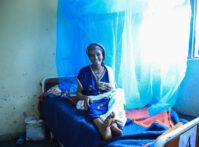-
It’s Not a Drug, It’s Not a Device – It’s Women Working Together
May 29, 2013 By Schuyler Null“Cooperative nurturing is the natural state of humans,” said Anthony Costello, director of the University College London’s Institute for Global Health, during a side event yesterday here at the Women Deliver conference in Kuala Lumpur. Children and mothers are healthier when they have a support network, so the Institute for Global Health has partnered with a number of NGOs over the last two decades to form thousands of community-based women’s groups in Bangladesh, India, Nepal, and Malawi.
The goal of the groups is to create “dialogue, not monologue,” said panelist Dr. Dharma Manandhar, president of Mother and Infant Research Activities (MIRA) in Nepal and the institute’s initial partner. They asked communities very simple questions, like “why do mothers and babies die?” he said. The results convinced them to “focus on the demand side” of the maternal health equation by facilitating regular forums for continued discussion.
The organizers provided the women’s group, which meet on a regular basis, with some information (illustrated instruction cards) and equipment (home delivery kits, etc.), but the main effect was to create a place to share experiences and promote social consciousness. “Women’s groups create a desire for care,” Costello said, adding that some of the original group leaders in Nepal, where groups now operate independently, are currently running for local government offices.
Mothers Working Together in India, Bangladesh, and Malawi
Based on MIRA’s experience, the Ekjut project in India had similar success with women’s groups involving more than 18,000 pregnant women in the states of Jharkhand and Orissa. A randomized control trial found a 45 percent reduction in neonatal mortality compared to control areas, said panelist Dr. Nirmala Nair, as well as a “de-seasonalization” of neonatal mortality in places where the winter usually claimed more infants.
Ekjut is one of the first successful maternal and child health interventions in a region where tribals – one of the country’s most marginalized and hard-to-reach groups – represent such a high proportion of the population (40 percent of Jharkhand and Orissa’s 66 million people), Nair said.
The participatory, community-led model was also replicated with partners in Bangladesh, and most recently, Malawi, bringing refinements along the way.
In an evaluation after two years of work in Bangladesh, for example, the Perinatal Care Project (PCP) found they had had little if any effect on maternal and neonatal mortality rates, said panelist Kishwar Azad. The women’s groups they’d established continued to meet, however, because they the groups were one of the few options for women to meet outside the home regularly, Azad said. PCP realized that the ratio of groups per women was much higher in Bangladesh (1 group per 1,400 women) than in Nepal and India, so in 2008, the project added 648 new groups to bring the ratio down to 1 group per 300 women. The impact was noticeable, Azad said; the next survey found that neonatal mortality rates had declined 38 percent in intervention areas; women initiated breastfeeding earlier; and safe delivery kits were used more often. And, Azad joked after showing a slide about estimated costs saved over the lifetime of children and mothers, “economists tell me it’s very cost-effective.” Nair said that Ekjut calculated an estimated cost per life saved of $706 in India.
One of the lessons learned in Malawi, said panelist Florida Banda, is that communities move at their own pace. The MaiMwana and MaiKhanda programs did not see dramatic results until a Demographic and Health Survey was conducted five years after the programs began. But, Banda emphasized, if given the time, the success of these women’s groups shows that communities and women can solve their own problems.
Next Step, Scale Up?
There are some limitations to this approach, said Costello. The current data set relies on a relatively small number of studies. It takes time to develop. And in some places, first-time, young mothers – who are the most vulnerable to danger, both for themselves and their children – aren’t allowed to join the women’s groups for cultural reasons.
But the overall success of the method was recently validated by a meta-analysis and program review by Audrey Prost et al. and Cesar Victora and Fernando Barros in The Lancet. Victora and Barros conclude that the evidence warrants moving to large-scale implementation, albeit with continued monitoring:
One should never ask a barber if one needs a haircut. Likewise, one should never ask epidemiologists like ourselves whether more research is needed. Yet hundreds of thousands of mothers and millions of children younger than five years continue to die year after year, so a promising intervention such as participatory women’s groups can no longer be kept on the back burner. A prudent middle-of-the-road alternative is to scale up this approach vigorously in a selected number of countries, accompanied by rigorous evaluations.
Ending with what he called the Editor-in-Chief of The Lancet Richard Horton’s “best Tweet ever,” Costello said: “It’s not a drug. It’s not a vaccine. It’s not a device. It’s women, working together, solving problems, saving lives.”
Read the Global Health Initiative’s full coverage from Women Deliver, part of our Advancing Dialogue on Maternal Health series with the Maternal Health Task Force and UNFPA.
Sources: The Lancet.
Video Credit: MaiMwana and Ekjut profiles, courtesy of the University College London’s Institute for Global Health.
Topics: Africa, Asia, Bangladesh, community-based, development, Dot-Mom, education, featured, From Women Deliver, gender, global health, India, Malawi, maternal health, Nepal, nutrition, video, Women Deliver
 A Publication of the Stimson Center.
A Publication of the Stimson Center.






